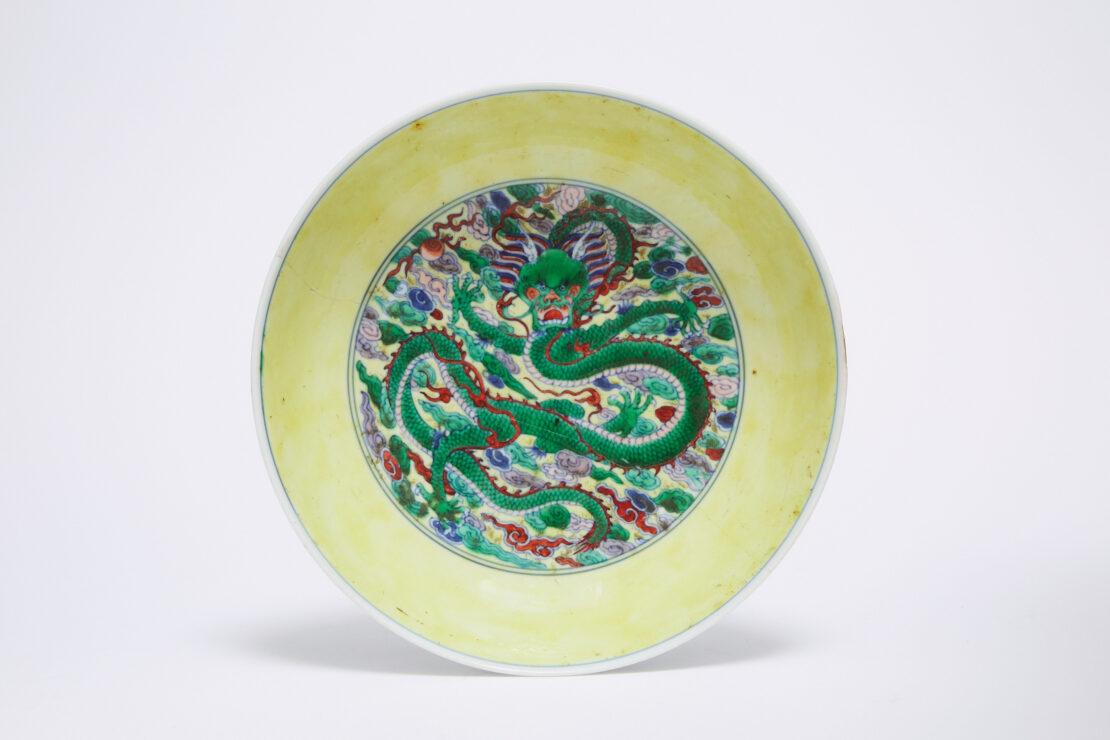Year of the Dragon at Auction
In keeping with 2024’s Year of the Dragon, Amelia Zhu, Senior Asian Art Specialist at Waddington’s Toronto and ISA member, collaborates with Austin Yuen, ISA Canadian Chapter Treasurer and fellow specialist at Waddington’s, to share a selection of Chinese works of art featuring dragons at auction.
One of the earliest depictions of dragons in archaeological findings is the “C-shaped dragon” from the Neolithic Hongshan culture, which flourished from the 5th to 3rd millennium BC. The premiere example of this form, chosen due to its rare large size, is in the collection of the National Museum of China. A separate example comes from Christie’s Hong Kong on November 29, 2017, previously from the Yangdetang Collection, which sold for 2,740,000 HKD (approximately $450,000 CAD).
The record for highest price achieved at auction by a work of art depicting dragons is held by Christie’s New York, which sold a painting on March 15, 2017 for $48,967,500 USD. The work is ink on paper in a handscroll format by the Southern Song dynasty artist Chen Rong (1235-1266). The painting was previously owned by the Qianlong Emperor (1711-1799) and included in his “Catalogue of Painting and Calligraphy in the Qianlong Imperial Collection” (Shi Qu Bao Ji), famously noted as the highest quality painting in the second series of his compilation. This painting set one of the main standards for dragon imagery that persists to this day. It was deaccessioned from the Fujita Museum, Osaka, as part of Christie’s “Important Chinese art from the Fujita Museum” auction.
A white jade dragon belt buckle plaque dating to the Yuan dynasty (1279-1368) sold at Waddington’s Toronto on September 28, 2023 for $96,750 CAD. This carving depicts a vivacious and fierce five-clawed dragon, dynamically rendered in high relief against a reticulated flower-scroll ground. In addition to being a direct artistic window into the brief and spirited Mongol-led Yuan dynasty, this jade plaque also indicates a high level of development in the jade crafting workshops during this period, in conjunction with the establishment of the Bureau of Gold and Jade in Hangzhou and Dadu (present-day Beijing) by Kublai Khan (1215-1294), the first emperor of the Yuan dynasty. This piece previously comes from the collections of Ernest Sirluck (1918-2013) and Samuel B. Nikitman (1899-1982).
Another dragon-related object that sold at Waddington’s is a yellow-ground ‘doucai’-enameled porcelain dish, marked and dated to the reign of the Kangxi Emperor (1662-1722). The use of these dragon-patterned porcelains were strictly regulated to certain hierarchical classes within the imperial court during this period. For example, porcelain wares brandishing yellow glazes and patterns of dragons were reserved for exclusive use by the royal family. The emperor was the sole user of dragon-patterned porcelain entirely decorated in yellow. The emperor, empress dowager, and empress used ceramics that were sumptuously glazed with yellow both inside and outside. By contrast, imperial noble consorts, who were second to the empress, used ceramics with yellow glaze on the exterior but with white glaze on the interior. Further down the hierarchy, the imperial concubines used porcelain of yellow ground decorated with green dragons, and other concubines used blue-ground porcelain with yellow dragons. This yellow-ground dish depicting a green dragon would have been commissioned specifically to the emperor’s concubines. The use of “doucai” enamels in this early Qing dynasty porcelain dish also contributes to its rarity and value.
During this spring season’s 2024 New York Asia Week, Sotheby’s offered a large gilt-decorated iron-red and underglaze-blue porcelain seal paste box and cover, bearing the mark and dating to the period of the Jiaqing Emperor (1796-1820). Due to the imagery of two dragons, specifically brandishing three claws rather than five, it is theorized that this box was commissioned during the early years of the Jiaqing Emperor’s reign, when his father Qianlong (1711-1799) still reigned as Emperor Emeritus. The popular depiction of two dragons often represented the proverb canglong jiaozi, translated as an old dragon teaching his son. The box eventually hammered for $444,500 USD.
In the Qing dynasty (1644-1911), another strictly regulated system of hierarchy within the imperial household was the imperial dress code. The colour “Minghuang”, or bright yellow, was reserved for the emperor, empress dowager, empress, and first rank consorts during formal occasions. “Jinhuang” (golden yellow), “Xinghuang” (apricot yellow), “Xiangse” (yellow with a greenish tinge), and “Qiuxiangse” (brown/plum) were worn by imperial family members of varying levels. Lower ranking nobles wore blue-ground robes. In regards to the dragons depictions themselves, dragons with five claws referred to as “long” were used exclusively for the robes and badges of the emperor. The next tier were five-clawed dragons called “mang”, and were assigned to the emperor’s sons, first-rank princes and their sons, and second-rank princes. The four-clawed “mang” dragons were assigned to the emperor’s grandsons, great-grandsons, and great-great grandsons, as well as princes from the third down to the seventh rank. Although eight and ninth rank nobles, along with court officials, did not wear dragon badges, their robes were still decorated with five-clawed “mang” dragons. This gold-thread purple-ground dragon robe dating to the Guangxu period (1875-1908) would have been reserved for the emperor’s kinsmen. The gold thread is incorporated by kneading and rolling gold leaf into thin strips, and then intertwining the gold with silk thread to create a malleable and weavable material. This technique was developed as a method of emphasizing luxury and beauty, showcasing the wearer’s prestige and status. Link: https://www.waddingtons.ca/auction/asian-art-apr-11-2024/gallery/lot/99/
Image credit: A Rare Yellow-Ground Doucai ‘Dragon’ Dish, Kangxi Mark and of the Period (1662-1722), courtesy of Waddington’s Auctioneers and Appraisers, Toronto.


